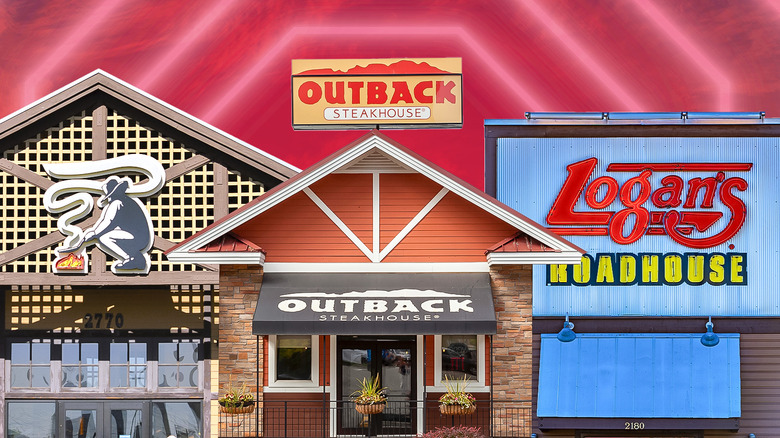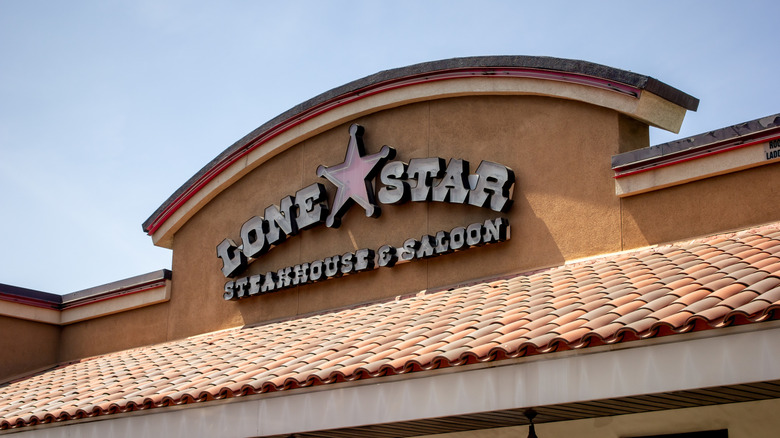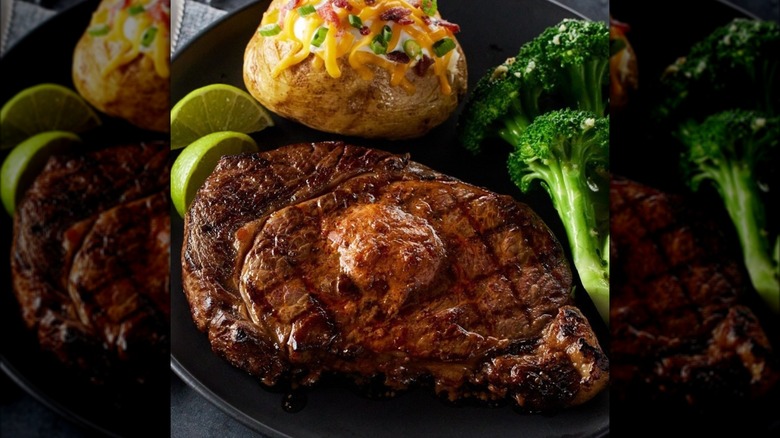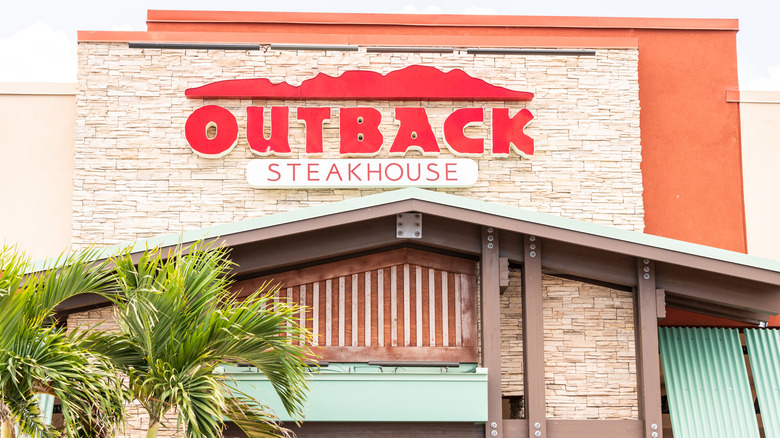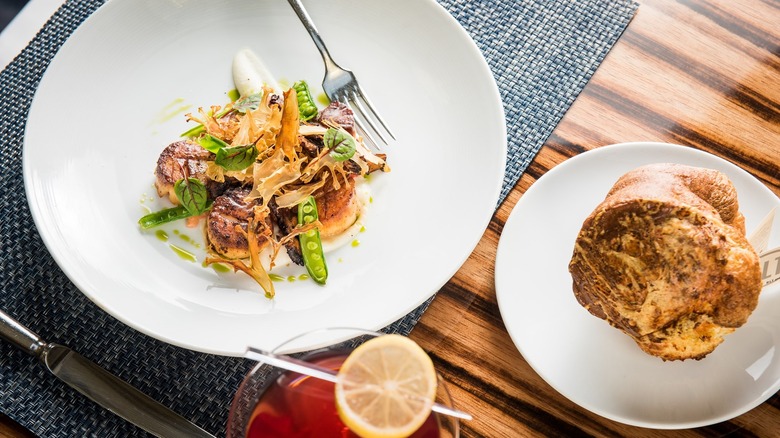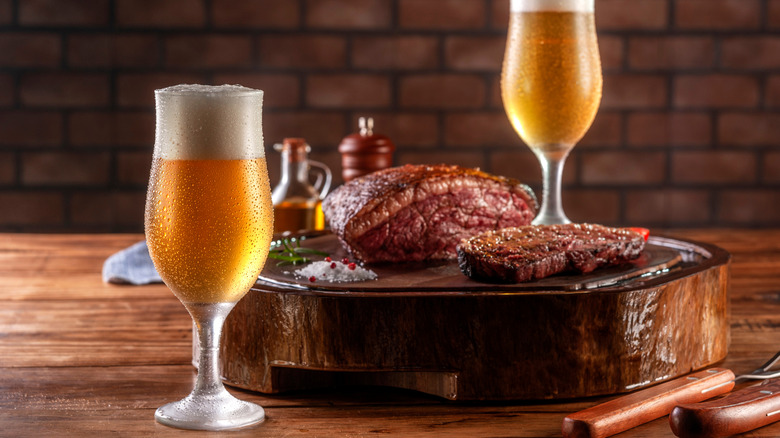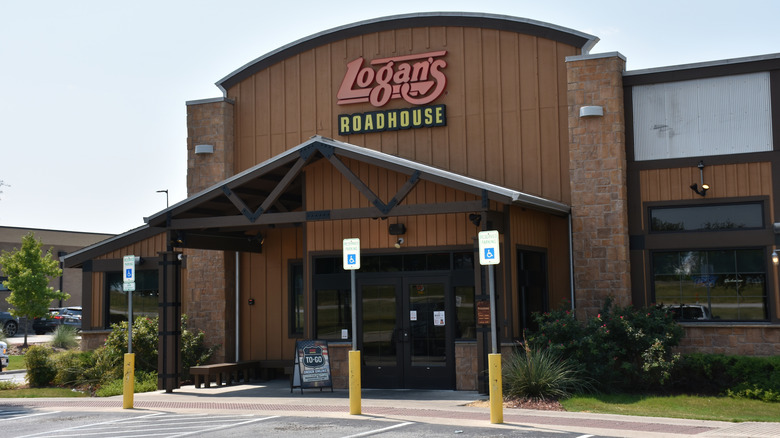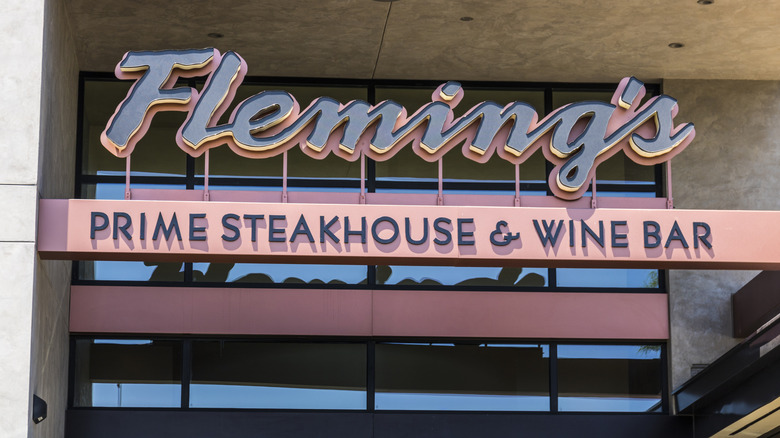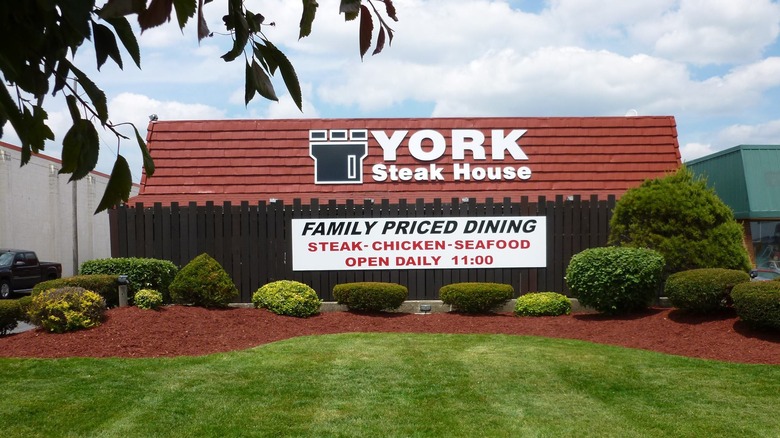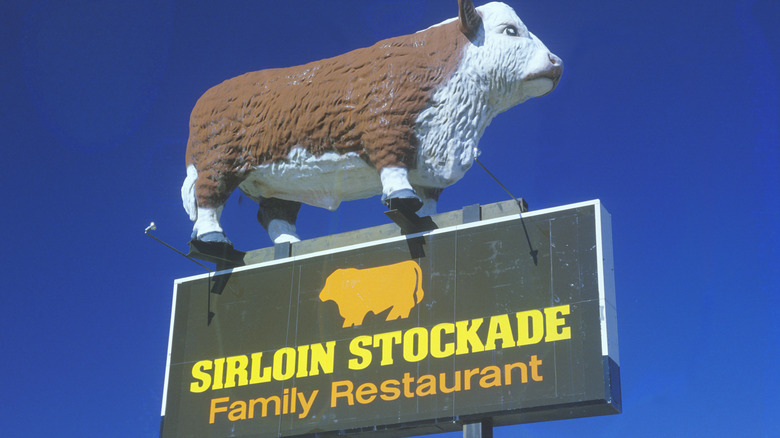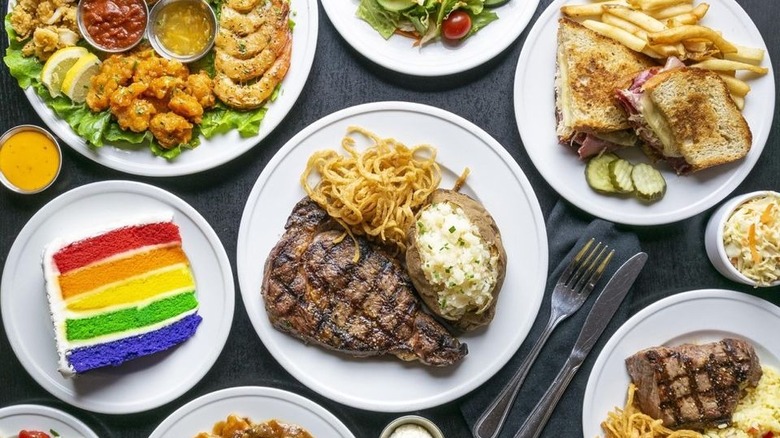These 10 Steakhouse Chains Are Fighting To Stay Open
Picture dim lighting that sets a cozy and inviting mood, a smoky aroma of seared beef drifting through the air, and a juicy slab of steak on your plate — in a familiar setting you can find in local restaurants and all across the country. These fond nostalgic memories of steakhouse chains reflect a fading food culture staple that defined past decades.
Back in the '80s, '90s, and '00s, casual dining chains were the place to be on a Friday night. Whether you piled into a booth with your friends after a school dance, celebrated a birthday with family, or took your crush on an awkward first date, your neighborhood's steakhouse chain provided an affordable experience that still felt upscale. However, these venues that once defined casual indulgence have loosened their hold on the American dining scene, falling victim to roadblocks like poor management, economic hardships, and cultural shifts.
Steakhouses aren't the only chain restaurants fighting to survive. Many casual dining establishments have been facing challenges since COVID-19, mostly due to rising food costs and stark competition from fast-casual rivals. And, while casual dining restaurants collectively saw a 9% spike in sales following the pandemic, the short-lived success didn't last. Once-popular dinner destinations like Red Lobster, Rubio's, and Buca di Beppo all buckled under bankruptcy in 2024. But, despite the shuttering of many locations, the demand for a sizzling steak on a mid-tier budget has kept some steakhouse chains in operation, even at a minuscule scale.
1. Lone Star Steakhouse & Saloon
Lone Star Steakhouse has dwindled to one lone location far from its namesake state. The restaurant's Western-themed food and atmosphere are now reserved for military members and their families stationed in Guam, or anyone else who is dedicated enough to take the 12-hour-plus flight to the Pacific island for the sake of a steak dinner — one that might not boast the best taste but that does offer a memorable experience catered for cowboy enthusiasts.
Once upon a time, Lone Star Steakhouse lived up to the "everything's bigger in Texas" reputation with grand-scale success that broke industry boundaries. From 1993 through 1995, Forbes named it the best small company in the country and, in '94, the business was the top-ranked restaurant on Fortune Magazine's list of the 100 fast-growing companies. At its height, Lone Star Steakhouse had over 260 locations. But its empire eventually crumbled, falling like the peanut shells that customers were encouraged to toss on the floor.
The once-popular chain featured a fun and laid-back vibe complete with buckets of free peanuts and lively country music blaring through the speakers. But, while it poured its efforts into appearances, the food lacked taste and quality. Unable to compete with better-performing competitors like Texas Roadhouse, the company was delisted from the stock market and sold in 2006. By 2017, it filed for Chapter 7 bankruptcy and abandoned all but its one remaining tropical location.
2. Black Angus Steakhouse
Promoting itself as "the American steakhouse," Black Angus dishes out traditional grillhouse staples. Along with its seasoned cuts that are aged a minimum of 21 days, you'll find classic steakhouse sides like mac 'n cheese, grilled veggies, and potato au gratin — hearty comfort food that's been attracting customers since the chain opened in 1964. But, recently, it's hit a hurdle that it might not be able to jump across.
While no business has escaped the recent rash of inflation, Black Angus' prices have ballooned more than the rest. For a fast-casual spot in line with other mid-tier restaurants like Outback Steakhouse — both in terms of quality and service — Black Angus demands its customers bite off more than they can chew price-wise. The restaurant's signature Campfire Feast has seen a 40% rise in price since 2020.
With just 32 locations open as of 2024, Black Angus Steakhouse is rumored to be trading pennies on the dollar, a sign that shareholders have little faith in the company's recovery. Though company officials state that the business is showing "consecutive yearly gains," (via Restaurant Business) numbers show that Black Angus sales dropped almost 29% between 2018 and 2023 and, in 2024, investment bankers were exploring selling the chain, according to Debtwire. With such uncertainty, you might want to book a reservation to savor the Black Angus tender, all-American slabs of steak while you still can — just be sure to bring plenty of cash.
3. Outback Steakhouse
Outback Steakhouse is not one of the best-ranked steakhouses, but, when compared to other competitors on this list, the Australian-themed chain is not performing all that badly. It must be something in their Bloomin' Onion appetizer (that's crisped to the heavens) that keeps customers coming back despite pandemics, recessions, and rising inflation. But even its juicy steaks and mouthwatering apps don't always draw in crowds.
In an effort to combat profit loss, Outback's parent company, Bloomin' Brands, which also operates Bonefish Grill, Carrabba's Italian Grill, and Fleming's Prime Steakhouse & Wine Bar, decided to close 41 underperforming locations in 2024 — most of which were Outbacks. However, to counter the closures, the company will open up to 45 more restaurants, 15-18 of which will reportedly be the Aussie-themed steakhouse. Considering the upheaval will cost the company a jaw-dropping $100 million in revenue, this was clearly no light decision to make, but certainly a wise one while Bloomin' still has the budget for it.
4. BLT Prime and BLT Steak
BLT Restaurant Group launched in 2004 with a glamorous dream and a lofty budget. Spearheaded by Laurent Tourondel, the business featured sister chains, BLT Steak and BLT Prime, catering to the upper middle class and luxury clientele, respectively. (Ironically, the ritzier BLT Prime was favored by republican President Trump, while the slightly more modest BLT Steak served the democratic Obamas often).
But, behind the glitzy facade, lay a struggling business. Having suffered a loss of profits due to the pandemic shutdown, BLT Restaurant Group applied for a Paycheck Protection Program (PPP) loan in April 2020. The good news? It received $3.3 million in aid to pay its staff and keep operations rolling. Better yet, the Small Business Administration (SBA) granted $1.9 million in loan forgiveness a year later, leaving a sum of $1.3 million for the company to pay back. Still, the assistance wasn't enough. The brand applied for a second round of PPP loans in 2021, all while owing its majority owner, JL Holdings 2002 LLC, an anxiety-inducing $7.8 million. In 2022, it buckled under financial pressure and filed for bankruptcy.
Following its Chapter 11 filing, BLT Restaurant Group permanently shut the doors of most of its locations. Today, only the New York and Miami branches of BLT Prime remain up and running. As for BLT Steak, you'll need to get a passport and book a flight to an exotic out-of-country location like Turks & Caicos, Aruba, or Osaka to savor its elevated fare.
5. Steak and Ale
Named after the classic English pub food made with tender steak stuffed into a flaky pastry, this restaurant, despite hailing from Texas, was "inspired by the warmth of an English inn" (via Steak and Ale). It launched in 1966 and set the blueprint for casual dining chains to come, innovating concepts like the salad bar and offering a budget dining experience that was previously exclusive to the wealthy — namely, enjoying a sizzling steak dinner.
At the height of its success, the brand boasted almost 300 restaurants nationwide. But, by 2008, the once-booming business had already dwindled to 58 locations, mostly due to competition from other popular chains. The failing company was no match for the Great Recession, and it ceased operations that same year.
However, following a 16-year absence, the OG steakhouse chain made an epic comeback in 2024, opening one Minnesota-based location complete with signature Tudor style. The dream of the reopening has steadily gained traction among fans since a Facebook page dedicated to the chain started back in 2013.
While you should traditionally pair dark ale with steak and ale pie, you won't find it on the menu at this American venue. What you will encounter, though, are juicy, meaty meals with a cult following that inspired a legendary resurrection with no rumors of slowing down any time soon.
6. Logan's Roadhouse
An all-American steakhouse with Kentucky roots, Logan's Roadhouse opened in 1991 and flourished over the next two decades with a collection of accolades and a mini-empire spanning 22 states. But, while the chain continues to bring a fun, honky-tonk vibe, it drops the ball in the quality of its food and service. Customer reviews for Logan's Roadhouse have been ultimately unforgiving, ranking it the worst steakhouse chain in America. However, that's only the start of its problems.
Logan's Roadhouse was hit particularly hard by the coronavirus shutdowns, closing all of its 261 locations in 2020. According to its parent company, Craftworks Holdings, the shutdowns happened after a lender retracted funding. Though the year was a challenging one, it was neither the beginning nor the end of the company's troubles. Like many other fast-casual chains, Logan's had experienced a decline in sales since the '00s and filed for bankruptcy for the first time in 2016. And, while it experienced temporary relief by reopening many of its restaurants after an acquisition by Fortress Investment Group, its numbers have now reduced to around 138 locations as of 2025.
Despite negative reviews and economic turbulence, Logan's Roadhouse still snagged a spot on Technomic's Top 500 Chain Restaurant Report of 2024. As long as someone out there still has an appetite for its doughy yeast rolls, Logan's stands a fighting chance at survival.
7. Fleming's Prime Steakhouse & Wine Bar
Not all casual dining chains are informal, case in point: the elevated Fleming's Prime Steakhouse & Wine Bar. This fine-dining establishment falls at the upscale end of Bloomin' Brands, the same company that owns other household names like Carrabba's, Outback Steakhouse, and Bonefish Grill. Boasting Wagyu beef and an impressive selection of Napa Valley red wines to pair with it, its elite menu draws in a crowd craving a familiar luxury dining experience found across the U.S.
Unfortunately, while Fleming's is on a higher level than other steakhouse chains, it's not above financial troubles. In 2024, Bloomin' decided to give 41 failing locations the boot after its net income fell from $58 million in 2022 to $43.3 million the following year. And, while the parent company didn't release a full list of the restaurants shuttering, it's known that some of them included Fleming's.
Though 2024 was a flop, Fleming's has been able to regain its footing in 2025. Unlike other steakhouse chains seeing their final days, Fleming's is opening new locations from California to Florida, achieving posh vibes complete with valet parking while offering discounted lunch menus.
8. York Steak House
Among the many adored vintage steakhouse chains, York Steak House opened in 1966 in Columbus, Ohio, with a kitschy castle theme and cafeteria-style service. Its grilled sirloins were a hit, and by the 1970s, the chain had expanded to nearly 180 locations under the wing of General Mills, almost exclusively in malls. But, by 1989, the crowds preferred the fast convenience of food courts while out shopping, and most of its locations were sold off.
Now, the restaurant is in a desperate fight for survival, with one lonely unit remaining in its Ohio hometown. According to the company's website, the family-owned and operated joint "strives to maintain the same quality and atmosphere, where loyal guests continue to have that past nostalgic experience, with a fresh, present-day appeal." It was purchased by Starliner Diner, a local Cuban restaurant, in 2024, after the previous operator retired. While the flavor doesn't beat other steakhouses, the nostalgia keeps people coming back.
9. Sirloin Stockade
Before Outback and Texas Roadhouse, people got their dose of sizzling protein at Sirloin Stockade. The restaurant ushered in a hybrid of family dining with buffet-style service back in 1966, filling stomachs with hearty portions of affordable steak along with mouthwatering sides and desserts, complete with a Western-themed ambiance. The chain gained traction throughout the Midwest and South, with about 200 establishments in its prime, most of which were easily recognizable by the iconic cow statues, which made for quirky roadside attractions.
Today, the corral-themed chain has shrunk down to seven locations scattered across Kentucky, Texas, Missouri, and Oklahoma. But, just because it's still open, doesn't mean it's thriving. In 2024, a TikTok video revealing dismal conditions at its Corsicana location — including allegations of black mold and tapeworms in the meat — went viral, leading to the temporary closure of the restaurant and a flood of insults from dissatisfied patrons. The other restaurants also feature their own set of bad reviews, but its loyal base of clients keeps the buffet-style chain slinging steaks for now.
10. Charlie Brown's Fresh Grill
Any meat-eater knows that steak tastes better at a restaurant, so it's no surprise that Charlie Brown's keeps serving its New Jersey clientele with mouthwatering cuts of beef. But even sumptuous steaks aren't always enough to draw in the crowds, a reality that the family-friendly Charlie Brown's chain experienced firsthand.
The East Coast restaurant that first went by Charlie Brown's Steakhouse was established in Westfield, New Jersey, in 1966 and maintained steady success over the following decades. By 1997, at the height of its reign as a Garden State icon, the chain operated 22 branches. It's this same year that would mark the regrettable fate of the business when Castle Harlan's Russell D'Anton became CEO. D'Anton eventually stepped down in 2008 and the restaurants were sold to CB Holding in 2009. One year later, D'Anton ended up pleading guilty to conspiracy to commit mail fraud and pocketing kickbacks from vendors that reached up to $1 million during his time heading up the chain, according to a statement released by the U.S. Attorney's Office.
The D'Anton scandal stained the reputation of the business and, to add insult to injury, employees also sued the brand in 2010. CB Holding filed for bankruptcy the same year, shuttering a significant number of its venues.
Things steadied for the steakhouse chain until the COVID-19 shutdown forced the business to close all remaining 13 locations. Luckily, the residents of Woodbury and Scotch Plains got some relief when the company's doors reopened in those locations. Sadly, the rest of New Jersey will have to take a road trip to enjoy a nostalgic Charlie Brown's steak and salad bar.
